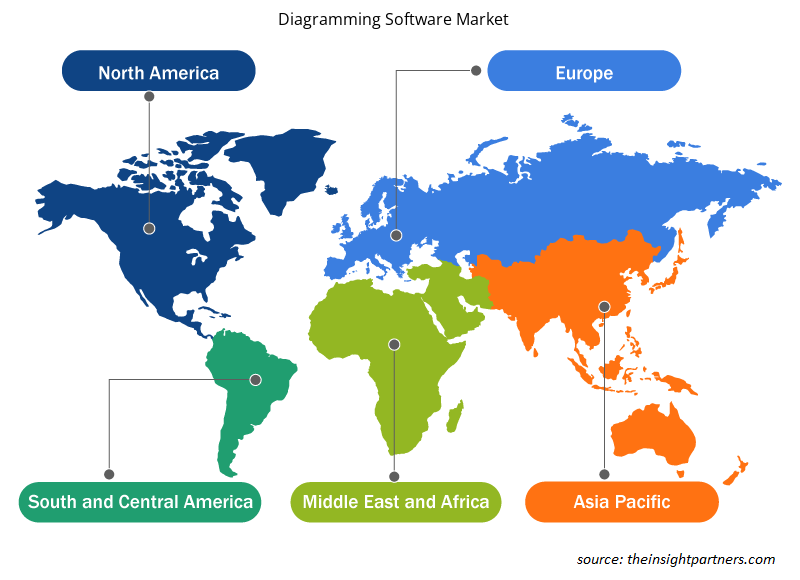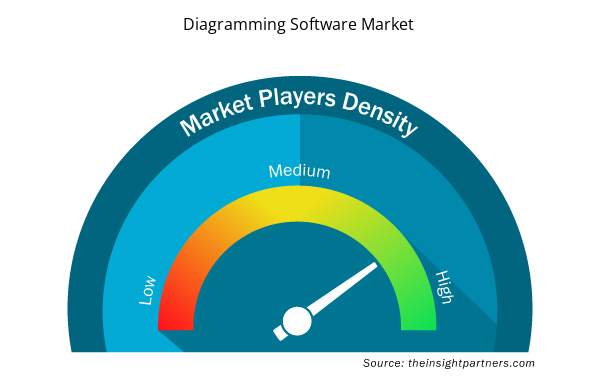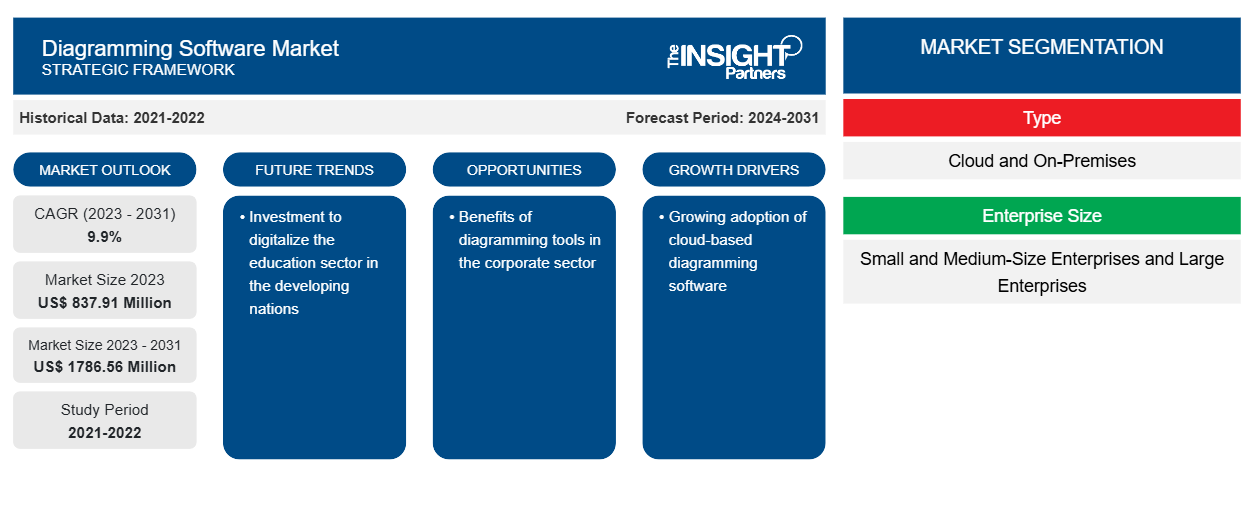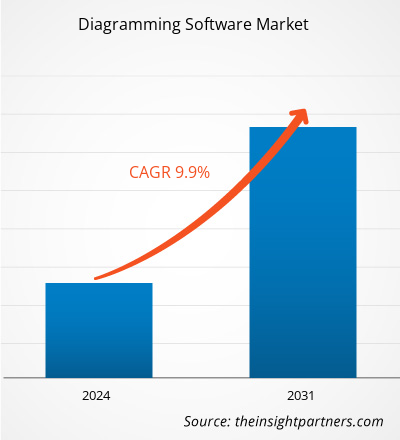من المتوقع أن يصل حجم سوق برامج الرسم البياني إلى 1786.56 مليون دولار أمريكي بحلول عام 2031 من 837.91 مليون دولار أمريكي في عام 2023. ومن المتوقع أن يسجل السوق معدل نمو سنوي مركب بنسبة 9.9٪ خلال الفترة 2023-2031. ومن المرجح أن يظل الارتفاع في الرقمنة والاعتماد المتزايد على برامج الرسم البياني المستندة إلى السحابة من الاتجاهات الرئيسية في السوق.
تحليل سوق برامج الرسم البياني
تكتسب سوق برامج الرسم البياني زخمًا بسبب التبني المتزايد من قبل الشركات الكبيرة والشركات الصغيرة والمتوسطة الحجم. يساعد تبني هذا البرنامج في تحديد سير العمل والعمليات بشكل أفضل في بيئة الأعمال . يمكن لأقسام مختلفة في المنظمة مثل التسويق والموارد البشرية والهندسة والعمليات استخدامها على نطاق واسع.
نظرة عامة على سوق برامج الرسم البياني
بمساعدة برنامج رسم المخططات البيانية، يمكن للمستخدم إنشاء مخططات تفصيلية، تتضمن مخططات انسيابية ومخططات دائرية ومخططات أرضية ومخططات أخرى، استنادًا إلى مجموعات البيانات والصور. يتضمن برنامج رسم المخططات البيانية قوالب مختلفة تساعد المستخدم على إنشاء المخطط من الصفر. يمكن لهذا البرنامج التكامل بسهولة مع أدوات ومنصات أخرى حيث يمكن لمستخدمين متعددين عرض المخطط والمساهمة في إنشائه.
قم بتخصيص هذا التقرير ليناسب متطلباتك
ستحصل على تخصيص لأي تقرير - مجانًا - بما في ذلك أجزاء من هذا التقرير، أو تحليل على مستوى الدولة، وحزمة بيانات Excel، بالإضافة إلى الاستفادة من العروض والخصومات الرائعة للشركات الناشئة والجامعات
- احصل على أهم اتجاهات السوق الرئيسية لهذا التقرير.ستتضمن هذه العينة المجانية تحليلاً للبيانات، بدءًا من اتجاهات السوق وحتى التقديرات والتوقعات.
برامج رسم المخططات البيانية: العوامل المحفزة والفرص في سوق البرمجيات
فوائد أدوات الرسم البياني في القطاع المؤسسي
تساعد المخططات البيانية في تقليل تعقيدات الاتصال. في بيئة الأعمال، توفر المخططات البيانية تمثيلًا مرئيًا واضحًا وموجزًا لعمليات الأعمال. كما تساعد في فهم جميع الموظفين فيما يتعلق بالأهداف والعمليات التي يجب اتباعها في تنفيذ المشروع. مع اعتماد أدوات المخططات البيانية، يمكن لقادة الفريق أو مديري المشاريع تسليم سير عمل المشروع لموظفيهم، وشرح ذلك باستخدام مخطط بياني. تساعدهم برامج المخططات البيانية في إنشاء مخططات دائرية ومخططات انسيابية والعديد من المخططات البيانية الأخرى. يساعد التمثيل المرئي لأهداف المشروع أو العمل الموظفين على فهم اتجاهات ونطاق المشروع بشكل أفضل. وبالتالي، تتبنى الشركات على نطاق واسع برامج المخططات البيانية.
اعتماد البرمجيات المستندة إلى السحابة
نظرًا لارتفاع مبادرات التصنيع والعولمة في كل من البلدان المتقدمة والنامية، فإن الأنشطة التجارية تنمو في جميع الصناعات. بالإضافة إلى ذلك، لوحظ أن الشركات تتبنى التحول الرقمي للحصول على ميزة تنافسية وتعظيم إنتاجيتها. ولهذا، تبحث الشركات عن حل فعال من حيث التكلفة، مما يؤدي إلى اعتماد حل برمجيات الرسم البياني المستند إلى السحابة .
تقرير تحليل تجزئة سوق برامج الرسم البياني
إن القطاعات الرئيسية التي ساهمت في اشتقاق تحليل سوق برامج التخطيط البياني هي نوع النشر وحجم المؤسسة والتطبيق.
- بناءً على نوع النشر، ينقسم سوق برامج الرسم البياني إلى سحابي ومحلي. احتل قطاع المحلي الحصة الأكبر من السوق في عام 2023.
- من حيث حجم المؤسسة، يتم تقسيم السوق إلى شركات صغيرة ومتوسطة الحجم وشركات كبيرة. ومن المتوقع أن ينمو قطاع الشركات الصغيرة والمتوسطة الحجم بأعلى معدل نمو سنوي مركب.
- بحسب حجم المؤسسة، يتم تقسيم السوق إلى مؤسسات تعليمية وشركات وموظفين. احتل قطاع المؤسسات التعليمية حصة كبيرة من السوق في عام 2023.
تحليل حصة سوق برامج الرسم البياني حسب المنطقة الجغرافية
ينقسم النطاق الجغرافي لتقرير سوق برامج الرسم البياني بشكل أساسي إلى خمس مناطق: أمريكا الشمالية، ومنطقة آسيا والمحيط الهادئ، وأوروبا، والشرق الأوسط وأفريقيا، وأمريكا الجنوبية والوسطى.
استحوذت منطقة آسيا والمحيط الهادئ على أكبر حصة في السوق ومن المتوقع أن تنمو بمعدل نمو سنوي مركب هو الأعلى. وتستحوذ دول مثل الهند واليابان والصين على غالبية حصة السوق في منطقة آسيا والمحيط الهادئ. ويُعد التحول الرقمي المتزايد أحد العوامل الرئيسية التي تؤدي إلى تبني الحلول الرقمية. كما تعمل منصات التعلم الإلكتروني المتنامية والشركات الصغيرة والمتوسطة الحجم المتنامية في الدول النامية على دفع تبني حلول برامج الرسم البياني.
رؤى إقليمية حول سوق برامج رسم المخططات البيانية
لقد قام المحللون في Insight Partners بشرح الاتجاهات والعوامل الإقليمية المؤثرة على سوق برامج الرسم البياني طوال فترة التوقعات بشكل شامل. يناقش هذا القسم أيضًا قطاعات سوق برامج الرسم البياني والجغرافيا في جميع أنحاء أمريكا الشمالية وأوروبا ومنطقة آسيا والمحيط الهادئ والشرق الأوسط وأفريقيا وأمريكا الجنوبية والوسطى.

- احصل على البيانات الإقليمية المحددة لسوق برامج الرسم البياني
نطاق تقرير سوق برامج الرسم البياني
| سمة التقرير | تفاصيل |
|---|---|
| حجم السوق في عام 2023 | 837.91 مليون دولار أمريكي |
| حجم السوق بحلول عام 2031 | 1786.56 مليون دولار أمريكي |
| معدل النمو السنوي المركب العالمي (2023 - 2031) | 9.9% |
| البيانات التاريخية | 2021-2022 |
| فترة التنبؤ | 2024-2031 |
| القطاعات المغطاة | حسب النوع
|
| المناطق والدول المغطاة | أمريكا الشمالية
|
| قادة السوق وملفات تعريف الشركات الرئيسية |
|
رسم مخطط كثافة اللاعبين في سوق البرمجيات: فهم تأثيره على ديناميكيات الأعمال
يشهد سوق برامج الرسم البياني نموًا سريعًا، مدفوعًا بالطلب المتزايد من المستخدم النهائي بسبب عوامل مثل تفضيلات المستهلك المتطورة والتقدم التكنولوجي والوعي المتزايد بفوائد المنتج. ومع ارتفاع الطلب، تعمل الشركات على توسيع عروضها والابتكار لتلبية احتياجات المستهلكين والاستفادة من الاتجاهات الناشئة، مما يؤدي إلى زيادة نمو السوق.
تشير كثافة اللاعبين في السوق إلى توزيع الشركات أو المؤسسات العاملة في سوق أو صناعة معينة. وهي تشير إلى عدد المنافسين (اللاعبين في السوق) الموجودين في مساحة سوق معينة نسبة إلى حجمها أو قيمتها السوقية الإجمالية.
الشركات الرئيسية العاملة في سوق برامج الرسم البياني هي:
- كرييتلي
- ارسم.io
- جليفي بواسطة بيرفورس
- إيدراوسوفت
- لوسيدشارت
- مايكروسوفت
إخلاء المسؤولية : الشركات المذكورة أعلاه ليست مرتبة بأي ترتيب معين.

- احصل على نظرة عامة على أهم اللاعبين الرئيسيين في سوق برامج الرسم البياني
أخبار سوق برامج الرسم البياني والتطورات الأخيرة
يتم تقييم سوق برامج الرسم البياني من خلال جمع البيانات النوعية والكمية بعد البحث الأولي والثانوي، والذي يتضمن منشورات الشركات المهمة وبيانات الجمعيات وقواعد البيانات. فيما يلي بعض التطورات في سوق برامج الرسم البياني:
- أطلقت Google أداة Google Cloud Architecture Diagramming Tool الجديدة تمامًا. تتيح هذه الأداة للمستخدم مشاركة الرؤية مع الفريق والتعاون معهم وتكرار التصميم وإنشاء الإصدار النهائي الذي يلبي بشكل أفضل متطلبات حالة الاستخدام التجاري. (المصدر: Google، بيان صحفي، فبراير 2022)
- أطلقت شركة EdrawMax، وهي شركة رائدة في مجال برامج رسم المخططات البيانية، نسختها المحمولة، تطبيق EdrawMax، والذي تم تصميمه لتمكين المستخدمين من إنشاء مخططات انسيابية ومخططات كتلية احترافية بسهولة. ويعمل التطبيق الجديد على تحسين الإنتاجية وتوفير الوقت للمستخدمين، حيث يوفر أكثر من 20 ألف قالب مخطط عالي الجودة يمكن للمستخدمين تخصيصه وتعديله لإنشاء مخططات بيانية مصقولة المظهر. (المصدر: PRNewswire، بيان صحفي، أبريل 2023)
تقرير سوق برامج الرسم البياني والتغطية والمنتجات النهائية
يوفر تقرير "حجم سوق برامج الرسم البياني والتوقعات (2021-2031)" تحليلاً مفصلاً للسوق يغطي المجالات التالية:
- حجم سوق برامج الرسم البياني وتوقعاته على المستويات العالمية والإقليمية والوطنية لجميع قطاعات السوق الرئيسية التي يغطيها النطاق
- رسم مخططات لاتجاهات سوق البرمجيات، بالإضافة إلى ديناميكيات السوق مثل المحركات والقيود والفرص الرئيسية
- تحليل مفصل لقوى PEST/Porter الخمس وSWOT
- تحليل سوق برامج الرسم البياني الذي يغطي اتجاهات السوق الرئيسية والإطار العالمي والإقليمي والجهات الفاعلة الرئيسية واللوائح والتطورات الأخيرة في السوق
- تحليل المشهد الصناعي والمنافسة الذي يغطي تركيز السوق، وتحليل الخريطة الحرارية، واللاعبين البارزين، والتطورات الأخيرة في سوق برامج الرسم البياني
- ملفات تعريف الشركة التفصيلية
- التحليل التاريخي (سنتان)، السنة الأساسية، التوقعات (7 سنوات) مع معدل النمو السنوي المركب
- تحليل PEST و SWOT
- حجم السوق والقيمة / الحجم - عالميًا وإقليميًا وقطريًا
- الصناعة والمنافسة
- مجموعة بيانات Excel



Report Coverage
Revenue forecast, Company Analysis, Industry landscape, Growth factors, and Trends

Segment Covered
This text is related
to segments covered.

Regional Scope
North America, Europe, Asia Pacific, Middle East & Africa, South & Central America

Country Scope
This text is related
to country scope.
الأسئلة الشائعة
The estimated value of the diagramming software market will be US$ 1786.56 million by 2031.
Creately, draw.io, Gliffy by Perforce, Edrawsoft, Lucidchart, Microsoft, FigJam, MyDraw, NULAB, and SmartDraw are some of the key players operating in the diagramming software market.
Investment to digitalize the education sector in developing nations is considered a key trend in the diagramming software market.
The rise in digitalization and growing adoption of cloud-based diagramming software are the key driving factors impacting the diagramming software market.
The global diagramming software market is estimated to register a CAGR of 9.9% during the forecast period 2023–2031.
Trends and growth analysis reports related to Technology, Media and Telecommunications : READ MORE..
The Insight Partners performs research in 4 major stages: Data Collection & Secondary Research, Primary Research, Data Analysis and Data Triangulation & Final Review.
- Data Collection and Secondary Research:
As a market research and consulting firm operating from a decade, we have published and advised several client across the globe. First step for any study will start with an assessment of currently available data and insights from existing reports. Further, historical and current market information is collected from Investor Presentations, Annual Reports, SEC Filings, etc., and other information related to company’s performance and market positioning are gathered from Paid Databases (Factiva, Hoovers, and Reuters) and various other publications available in public domain.
Several associations trade associates, technical forums, institutes, societies and organization are accessed to gain technical as well as market related insights through their publications such as research papers, blogs and press releases related to the studies are referred to get cues about the market. Further, white papers, journals, magazines, and other news articles published in last 3 years are scrutinized and analyzed to understand the current market trends.
- Primary Research:
The primarily interview analysis comprise of data obtained from industry participants interview and answers to survey questions gathered by in-house primary team.
For primary research, interviews are conducted with industry experts/CEOs/Marketing Managers/VPs/Subject Matter Experts from both demand and supply side to get a 360-degree view of the market. The primary team conducts several interviews based on the complexity of the markets to understand the various market trends and dynamics which makes research more credible and precise.
A typical research interview fulfils the following functions:
- Provides first-hand information on the market size, market trends, growth trends, competitive landscape, and outlook
- Validates and strengthens in-house secondary research findings
- Develops the analysis team’s expertise and market understanding
Primary research involves email interactions and telephone interviews for each market, category, segment, and sub-segment across geographies. The participants who typically take part in such a process include, but are not limited to:
- Industry participants: VPs, business development managers, market intelligence managers and national sales managers
- Outside experts: Valuation experts, research analysts and key opinion leaders specializing in the electronics and semiconductor industry.
Below is the breakup of our primary respondents by company, designation, and region:

Once we receive the confirmation from primary research sources or primary respondents, we finalize the base year market estimation and forecast the data as per the macroeconomic and microeconomic factors assessed during data collection.
- Data Analysis:
Once data is validated through both secondary as well as primary respondents, we finalize the market estimations by hypothesis formulation and factor analysis at regional and country level.
- Macro-Economic Factor Analysis:
We analyse macroeconomic indicators such the gross domestic product (GDP), increase in the demand for goods and services across industries, technological advancement, regional economic growth, governmental policies, the influence of COVID-19, PEST analysis, and other aspects. This analysis aids in setting benchmarks for various nations/regions and approximating market splits. Additionally, the general trend of the aforementioned components aid in determining the market's development possibilities.
- Country Level Data:
Various factors that are especially aligned to the country are taken into account to determine the market size for a certain area and country, including the presence of vendors, such as headquarters and offices, the country's GDP, demand patterns, and industry growth. To comprehend the market dynamics for the nation, a number of growth variables, inhibitors, application areas, and current market trends are researched. The aforementioned elements aid in determining the country's overall market's growth potential.
- Company Profile:
The “Table of Contents” is formulated by listing and analyzing more than 25 - 30 companies operating in the market ecosystem across geographies. However, we profile only 10 companies as a standard practice in our syndicate reports. These 10 companies comprise leading, emerging, and regional players. Nonetheless, our analysis is not restricted to the 10 listed companies, we also analyze other companies present in the market to develop a holistic view and understand the prevailing trends. The “Company Profiles” section in the report covers key facts, business description, products & services, financial information, SWOT analysis, and key developments. The financial information presented is extracted from the annual reports and official documents of the publicly listed companies. Upon collecting the information for the sections of respective companies, we verify them via various primary sources and then compile the data in respective company profiles. The company level information helps us in deriving the base number as well as in forecasting the market size.
- Developing Base Number:
Aggregation of sales statistics (2020-2022) and macro-economic factor, and other secondary and primary research insights are utilized to arrive at base number and related market shares for 2022. The data gaps are identified in this step and relevant market data is analyzed, collected from paid primary interviews or databases. On finalizing the base year market size, forecasts are developed on the basis of macro-economic, industry and market growth factors and company level analysis.
- Data Triangulation and Final Review:
The market findings and base year market size calculations are validated from supply as well as demand side. Demand side validations are based on macro-economic factor analysis and benchmarks for respective regions and countries. In case of supply side validations, revenues of major companies are estimated (in case not available) based on industry benchmark, approximate number of employees, product portfolio, and primary interviews revenues are gathered. Further revenue from target product/service segment is assessed to avoid overshooting of market statistics. In case of heavy deviations between supply and demand side values, all thes steps are repeated to achieve synchronization.
We follow an iterative model, wherein we share our research findings with Subject Matter Experts (SME’s) and Key Opinion Leaders (KOLs) until consensus view of the market is not formulated – this model negates any drastic deviation in the opinions of experts. Only validated and universally acceptable research findings are quoted in our reports.
We have important check points that we use to validate our research findings – which we call – data triangulation, where we validate the information, we generate from secondary sources with primary interviews and then we re-validate with our internal data bases and Subject matter experts. This comprehensive model enables us to deliver high quality, reliable data in shortest possible time.


 احصل على عينة مجانية لهذا التقرير
احصل على عينة مجانية لهذا التقرير